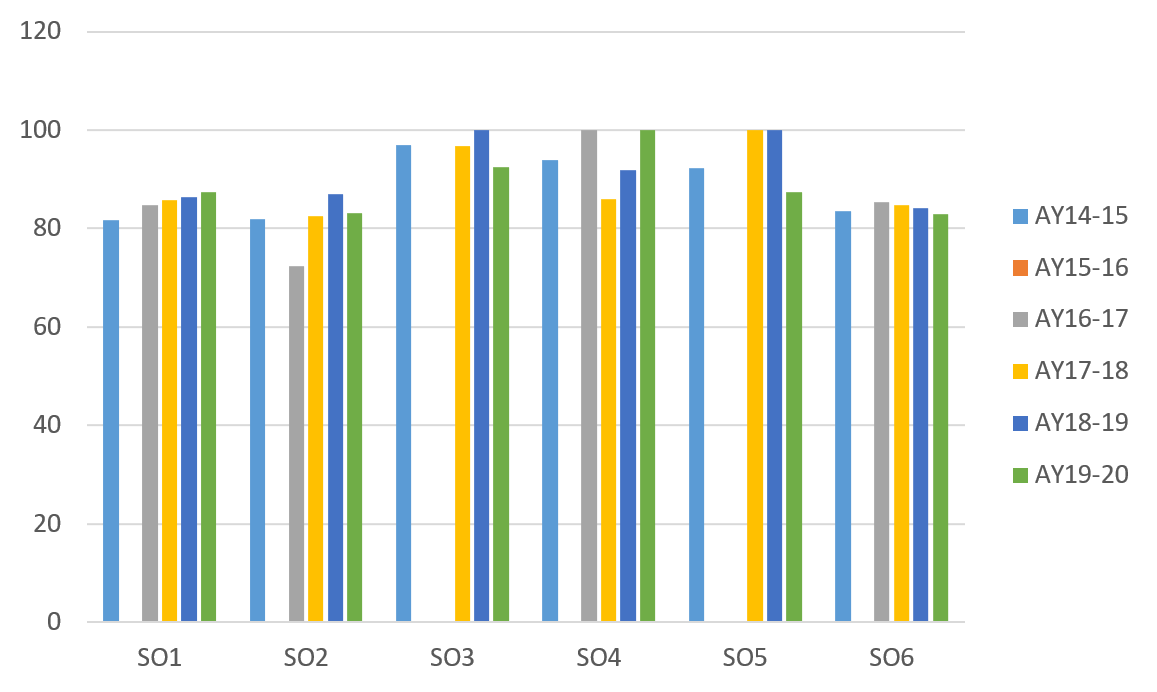Student Outcome Evaluation Summary Results
The following figure summarizes the Course Direct Measures (CDMs) evaluation score for each of six Student Outcomes (SOs) in the past six academic years. Here, the x-axis represents the category of SOs from 1 through 6 and the y-axis represents the average percentage of the students who achieve a score of 3 or above for the performance indicators. It should be noted that no CDMs were collected in the academic year 2015-2016 to focus on analyzing CDM data and improving the assessment procedures. The figure shows that the satisfactory attainment level for SO(1) increases each academic year. The attainment level for SO(2) is dropped significantly to below satisfactory in the third academic year and gradually improves in the fourth and fifth academic years and decreases a little in the sixth academic year, possibly due to the introductory programming language changes. The attainment level for the recent three academic years stays around 83%. The satisfactory attainment level for SO(3) stays above 90% for all six years. The attainment level for SO(4) is satisfactory and fluctuates from year to year. But its attainment level gradually improves since Fall 2017. The attainment level for SO(5) is satisfactory for the past six years. Its score significantly drops in the last year possibly due to the complexity level of the group project. The satisfactory attainment level for SO(6) stays around 84%. The CDM data shows that the CS program meets the ABET criteria and achieves the expected SOs for its curriculum.

The following figure summarizes the Senior Exit Surveys/Interviews (SES) evaluation score for each of six SOs in the past six academic years. Here, the x-axis represents the category of SOs from 1 through 6 and the y-axis represents the percentage of the students’ response to their competency level at a score of 3 or above. It shows that the satisfactory attainment level for each of six SOs ranked by students themselves is high with all the percentages being above 90%. The attainment level for SO(1) increases in the past five years. The attainment level for SO(2) is dropped significantly in the second academic year, gradually improves for the next three years, and dropped a bit in the past two years. The satisfactory attainment level for SO(3) fluctuates from year to year but stays in the increasing trend in the past three years. The attainment level for SO(4) is satisfactory but dropped significantly in the past year. The attainment level for SO(5) is satisfactory and stays above 96% for the past six years. The satisfactory attainment level for SO(6) has a big drop in the third academic year and shows an increasing trend since then.

Overall, the SES data shows that almost all graduating CS students are happy with the CS curriculum and confident that they will function effectively as a member or leader of a team engaged in activities appropriate to the program’s discipline. Their self-ranking on mastering at least two programming languages and mastering the core curriculum with regards to principles and practices for problem/solution analysis and design exhibits an increasing trend at the highest competency level in the past four years. However, we need to strategically incorporate the ethics component in most pre-professional CS courses to get students exposed to ethics throughout their undergraduate studies.
Based on the results presented above, it is clear that the department, in general, is doing an excellent job of meeting the SOs. This is not unexpected as the Computer Science program at USU is a mature program that has operated successfully for many decades. However, we stress that a score of 3 or above in the assessment process does not mean that our students are all doing above average work; it does indicate that they are satisfactorily achieving the SO as measured by the assessment tools.
The Industrial Advisory Committee (IAC) report each year has been generally positive. Since it only provides qualitative feedback, we cannot provide data analysis results here. It should be noted that all the IAC members mentioned that they are always pleased with the caliber from USU’s CS program and would love to recruit USU undergraduate and graduate students to be interns at their companies and then offer the full-time positions to them if there are openings. In each of the past three academic years, around 70 undergraduate students participated in the internship co-op program. Most of them work in companies around the Salt Lake City area. Ninety-five percent of their employers are pleased with the performance of their interns and communicated with the internship coordinator about their interest to continue hiring the students for a full-time job. All of these indirectly demonstrate the success of the CS program to provide contributing professionals in diverse career paths, to be effective communicators and team members, to solve real world problems, and foster personal and organizational growth, which supports the program’s program educational objectives.

